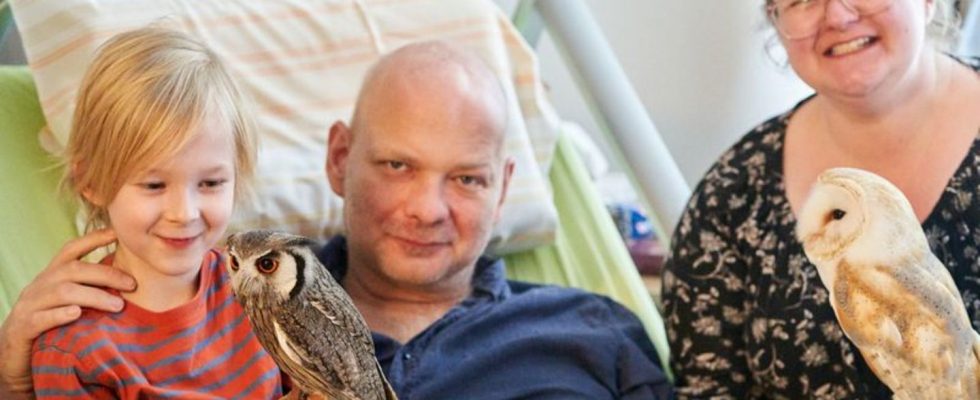Company
“Balm for the soul”: When owls visit the hospice
Swen Pinkatschek (M), who suffers from a brain tumor, is happy with his wife Tamara and his son Claas (7) about the visit of barn owl Emma and white-faced owl Merlin. photo
© Sascha Ditscher/dpa
Stroke and cuddle welcome! Therapy owls ensure very special moments when visiting a Koblenz hospice. With the tame birds, the “falconers of hearts” are now on the road nationwide.
Horst Demsky is weak and can no longer get up. That’s why the owls in the St. Martin Hospice in Koblenz come to visit his bed. They sit quietly on the bed covers in falconer’s gloves, Demksy caresses their feathers. “Darling, fine,” he says to them in a low voice. And after a while: “I also had two parrots.” He smiles again and again while falconer Katharina Häfner introduces him to the birds: barn owl Emma and white-faced owl Merlin – with the bright orange eyes.
There are recognizable minutes of joy that the animal visit triggers in Demsky. This is exactly why Häfner offers animal-assisted therapy with owls. With her “Falkner der Herzen” team, which is based in Bisterscheid in the North Palatinate, she visits hospices and palliative children’s hospices nationwide on a voluntary basis. In hospices, the terminally ill are accompanied and cared for in the last phase of their lives. “We bring joy and maybe a bit of luck to the people there,” says Häfner (29).
“A very special event”
It was successful with Demsky. “It was a nice surprise,” he says. The owl’s visit, now the third in the hospice, is “a very special event,” says deputy hospice director Ingrid Ferdinand. You can experience the enthusiasm the animals aroused in the seriously ill people. “People always say: Everything is so sad in the hospice. One of our principles is that we live the day we have as well as possible. And that’s such a highlight.”
Also for relatives. Swen Pinkatschek is lying in another of the ten rooms. brain tumor. His wife is sitting by his bed. She is happy when her son Claas comes into the room with the little owl Merlin and falconer Häfner with the barn owl. “This is the first time that owls are so close to us,” says Tamara Pinkatschek. Claas, who has his seventh birthday that day, puts the owl on the bed and shows: “Dad, you always have to pet it here, she likes it.” The special moment is captured with many photos.
“People are starting to talk more”
“Owls bring a lot of peace. Owls make you quiet,” says falconer Häfner, who was born in Eutin in Schleswig-Holstein. That might be something that is a bit different than similar missions with other therapy animals such as dogs or alpacas. From her experiences with the owls, she says: “People are starting to talk more.” And such a visit brings back many memories. “You open a door in your head.”
For example, when visiting people with dementia or Alzheimer’s. Häfner says: “You ask: What’s your name? And then the person says “Dirk Müller”. And the nursing staff stands next to them and says: “He actually hasn’t known his name for five years”.
Hospice resident Jose Lay is also enthusiastic about the owls. He’s been an “owl fan” since childhood, he says on the terrace of the Koblenz hospice. “I also heard owls at my house in the evenings.” In his room he has a collection of owl figurines made of ceramics, among other things. “Owls are very intelligent and very beautiful animals”. During the visit, he only has eyes for the owls and also strokes a large owl. “I’ve never been so close. It’s a beautiful experience.”
“You get a lot of love and affection”
“Cuddle, caress and kiss – that’s all possible,” says falconer Häfner about dealing with the therapy birds. “You’re used to it.” The animals were raised by hand from an early age. “We get them when they are 10 to 14 days old. They live in our kitchen and lie on the sofa in the living room with us at night and they get a lot of love and affection.” And they would know: “If I’m sitting on a glove, then that’s working time.”
In the falconry in Bisterscheid there are a total of 45 birds, most of which are owls. Häfner has been in the team for six years, her husband Achim Häfner has been doing it for more than 20 years. They also visited retirement homes, schools, kindergartens and institutions for the disabled, which paid for visits. In Berlin there are a particularly large number of facilities that they book, says Katharina Häfner. “We’re there twice a year for two to three weeks.”
“This is balm for the soul”
For her, a visit like the one in Koblenz is “a fulfillment and a total matter of the heart”: “If I have a person who I have reached deep in my heart, then I did it for exactly that person. Then it was just right for them.” , she says.
The stationary hospice in Koblenz wants to repeat the owl visit in the future. The “guests” in the hospice have diseases that have been completely treated. “We’re going over to the palliative,” says Ferdinand. Caregivers and nurses also drew strength from an experience like the owl’s visit. “This is balm for the soul. For both sides.”

